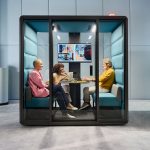Downloads and Resources
Race For Talent: Communicate Company Values Through Design
Today it’s more critical than ever for organizations to attract and retain top talent, and one component that can be used for recruiting, but is often overlooked, is the workplace. It’s more than just desks and chairs. Research shows that the work environment accounts for up to 25% of job satisfaction. Offering workers an attractive […]
Read More....Workplace Trends Influencing Law Firms
Over the past decade, the amount of workspace devoted to conference, training and breakout areas has increased by almost 20% while individual workspaces are losing ground. With smaller footprints, shorter leases and less square footage available, a new way of thinking about how space is designed and utilized is emerging. Demands for more efficiency, collaboration, […]
Read More....Movable Walls & Raised Floors: Optimizing Adaptable Workplaces to Meet Changing Business Needs
Floors and walls, typically, are immovable objects. Within traditional construction, they are placed with great effort. Thus, space owners are often reluctant to change floorplan configurations because of the significant initial investment during construction. Unfortunately, the inflexibility of workspaces can impact the organization in negative ways, further depleting resources and reducing the organization’s ability to […]
Read More....Erogonomics Cost Justification
According to research, upper extremity musculoskeletal symptoms among computer users are reported to be as high as 63%. Making changes to the work environment to improve the safety and health of workers will often reduce a company’s costs, improve productivity and quality issues, and decrease the chance that employees will file a complaint with the […]
Read More....Don’t Sit Still: Promoting Back Health While Seated
Research has found that 75 percent of work in industrialized countries is performed while seated (Pynt et al, 2008). Some workers sit for long periods of time while others get out of their chairs at least a couple of times per hour. Either way, it is important for all workers to understand how to keep […]
Read More....Designing for focus at work
Employers need open and interactive spaces to encourage collaboration, and such spaces can introduce distractions. Distractions, however, sabotage focus, and focus work is a necessary part of collaborative efforts. How can we solve this conflict? Approach workplace design so that it encourages both collaboration and focus work: Offer employees a variety of workspace options, choice […]
Read More....Laptop Computers and Ergonomics
Laptop computers were not originally designed for long-term use. But with all of the advancements made in technology, more and more people are using laptops as their main computers. Working on a laptop can put a user in some awkward postures. That’s why this paper will discuss ergonomic guidelines for setting up a computer workstation […]
Read More....Effective Benching
Benching is more than just a piece of office furniture; it’s a method of working. It is most appropriate when designing environments that need to be creative, flexible, adaptable, and energized (Wassenaar, 2011). While benching can be applied in many situations, it is best suited to dynamic, interactive, social work styles and not as effective for a task or a […]
Read More....Compelling Branded Environments in Higher Education
The world of higher education faces many challenges. Ever-increasing tuition is prompting students and their families to take a close look at the value being offered by the schools being considered. Rising costs are compelling many students to consider alternatives to the traditional four-year university, including competitors that offer online education. Even in traditional institutions, emerging technologies and the […]
Read More....Active Ergonomics
The goal of today’s office ergonomics is focused on fitting the workspace and technology to the individual. However, the very nature of work is changing. Technology has freed people to work anywhere, and a growing proportion of that work is collaborative and social. But traditional office ergonomics does not address group work or spaces. These emerging space types […]
Read More....









